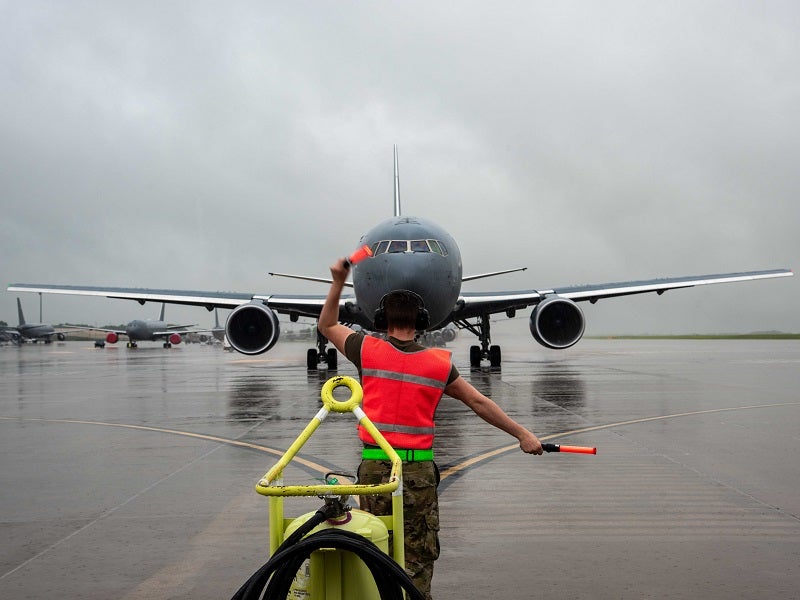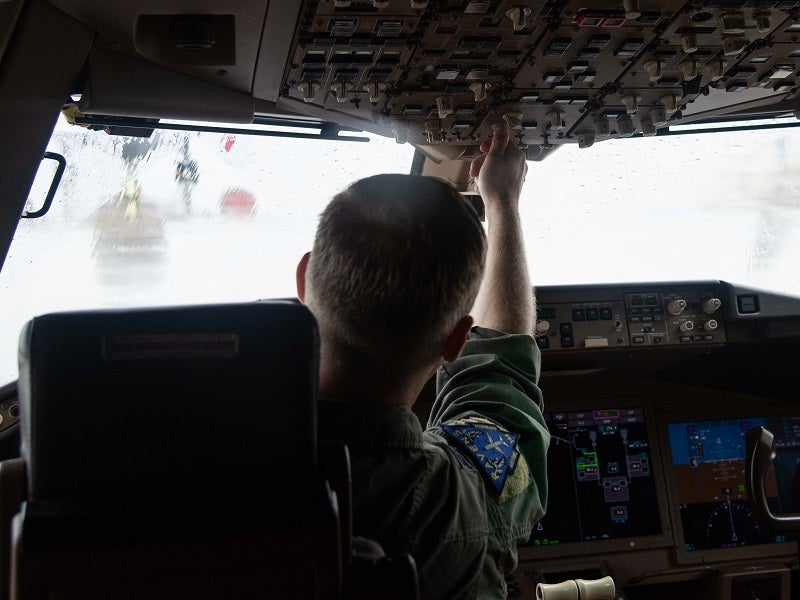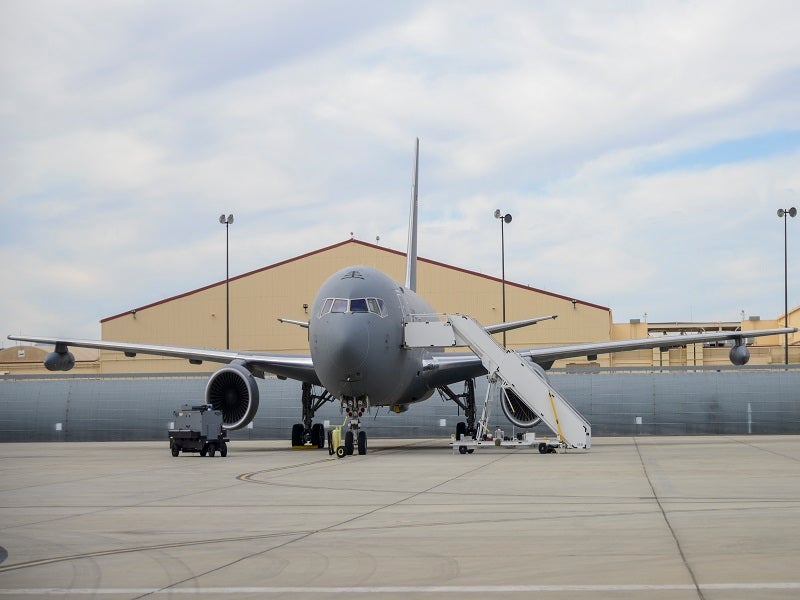KC-46A aerial refuelling aircraft, based on the KC-767 refuelling aircraft, is manufactured by Boeing under a contract with the US Air Force (USAF). The contract calls for the manufacturing of 179 KC-46 tankers to replace the old KC-135 tankers that have been in service since 1965.
The KC-46A is a wide-body, multi-mission aircraft capable of transporting fuel, cargo, passengers, and patients.
Boeing will deliver the entire KC-46 tanker fleet by 2027. The programme is expected to generate more than 50,000 jobs and will involve about 800 suppliers.
The KC-46 tanker programme received the Supplemental Type Certificate (STC) from the US Federal Aviation Administration (FAA) in September 2018. The USAF received 42 KC-46A Pegasus tankers, as of January 2021.
The aircraft are stationed at different USAF bases including McConnell Air Force Base, Pease Air National Guard Base, Altus Air Force Base, and Seymour Johnson Air Force Base.
KC-46A aerial refuelling aircraft design
KC-46A is based on KC-767 but modifications were made to the airframe by incorporating a cargo door and an advanced flight deck display. The airframe is militarised with air refuelling capabilities, an air refuelling operator station and threat detection and avoidance systems.
The tanker is capable of carrying 18 cargo pallets, as well as transporting 58 passengers normally and up to 114 passengers during contingency operations. The tanker aircraft also provides urgent aeromedical evacuation by transporting 54 medical patients. It weighs about 94,198kg, while the maximum take-off weight is 188,241kg.
The aircraft has a length of 165ft 10in (50.5m), wingspan of 156ft 1in (47.5m), and overall height of 52ft 10in (16.1m). It has a maximum cargo capacity of 65,000lb (29,484kg).
Details of Boeing’s KC-46 tanker aircraft programme
The contract for KC-46 tankers was awarded to Boeing in February 2011. The company announced the major suppliers to be involved in the project in June 2011 and the Integrated Baseline Review (IBR) for the programme was completed in August the same year.
Boeing also completed the system requirements review, firm configuration reviews and preliminary design review (PDR) prior to the start of assembling the first refuelling boom. The critical design review (CDR) was completed in September 2013 and the first test aircraft was rolled out in early 2014.
The first Tanker System Integration Laboratory (SIL) to support testing and reduce risk during manufacture was opened in September 2012. A total of six aircraft have been built for the KC-46 tanker test and certification programme, with the first test aircraft performing its maiden flight in September 2015.
Boeing received a $2.8bn contract from the USAF in August 2016 for the first two low-rate initial production lots of seven and 12 aircraft. A contract worth $2.1bn for the third KC-46 tanker production lot of 15 aircraft and spare parts was awarded in January 2017. The USAF awarded a $2.9bn contract to Boeing for the fourth production lot of 18 KC-46A tanker aircraft.
KC-46A’s maiden flight was conducted in December 2017 and the receiver certification testing of the aircraft began in April 2018. Phase II receiver certification flight testing was completed in December 2018, while the phase III testing is scheduled for 2019.
The flight tests required for the delivery of the first KC-46 tanker were completed by the US Air Force in July 2018.
Boeing secured a $2.9bn contract from the USAF in September 2018 for the delivery of 18 additional KC-46 tanker aircraft, increasing the total to 52.
The Japan Air Self-Defense Force (JASDF) placed a $279m order with Boeing for the delivery of a KC-46 tanker and logistics support in December 2017. An option was exercised by the USAF for the sale of a second KC-46 tanker to the Japan Air Self-Defense Force under foreign military sale (FMS) programme in December 2018.
The maiden flight of the first KC-46 tanker for the JASDF was conducted in February 2021. The aircraft is currently in the certification phase of development. The first refuelling flight of the Japan-bound tanker was completed in August 2021. In June 2019, the KC-46A completed its first mid-air connection with the B-2 Spirit stealth bomber during the developmental testing of the aircraft at the Edwards Air Force Base.
The USAF awarded a contract worth $1.7bn for the sixth production lot that includes the delivery of 12 KC-146A tankers, in January 2021. Another order worth $2.1bn was awarded in the same month for the delivery of 15 additional aircraft, bringing the total USAF orders to 94.
In July 2021, the tanker reached the milestone of completing 5,000 sorties since the delivery of the USAF’s first aircraft in January 2019. The operational use of the centreline drogue system mission set was approved by the US Air Mobility Command (AMC) as the first interim capability release (ICR) milestone of the tanker in July 2021. The ICR declaration is key to meet the extensive aerial refuelling requirements of the joint force.
KC-46A aerial refuelling method
KC-46 has a maximum fuel capacity of 212,299lb (96,265kg). The aircraft is fitted with a flush-mounted air-to-air refuelling receptacle capable of accepting fuel at 1,200gal/min.
The refuelling systems also include a digital fly-by-wire boom capable of offloading fuel at 1,200gal/min, as well as a permanent centreline drogue system and removable wing air refuelling pods that can offload fuel at 400gal/min each.
Refuelling systems aboard the KC-46 can be managed by boom operators from the crew compartment featuring an Aerial Refuelling Operator Station (AROS). High resolution cameras are placed at the fuselage to provide a full view of the field.
The fly-by-wire boom system enables the boom operator to refuel all fixed-wing receiver aircraft irrespective of time and mission. It is capable of carrying out simultaneous multipoint refuelling through the wing air refuelling pods.
KC-46A cockpit, engines and performance
KC-46 can accommodate three main crew members, including two pilots and a boom operator. There are 12 additional permanent seats for the aircrew including the aeromedical evacuation crew of two flight nurses and three medical technicians.
The aircraft features an integrated display system featuring diagonal crystal displays, a tactical situational awareness system (TSAC) and a remote vision system (RVS) combining both 3D and 2D technology for the boom operator. It is also equipped with communications, navigation, surveillance, networking and flight control systems provided by Rockwell Collins.
The mission control system is supplied by GE Aviation Systems, while the onboard auxiliary power unit, cabin pressure control system and air data inertial navigation systems were provided by Honeywell. Northrop Grumman supplied the infrared countermeasures system for the aircraft.
Each USAF KC-46A tanker is powered by two Pratt & Whitney PW4062 engines, with each delivering 62,000lb (289.13kN) of thrust. Each PW4062 engine has a fan-blade diameter of 94in.
KC-46A can fly at a maximum speed of 915km/h and the maximum air speed is 851km/h. The range and service ceiling of the aircraft are 12,200km and 12,200m, respectively.




